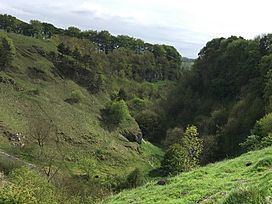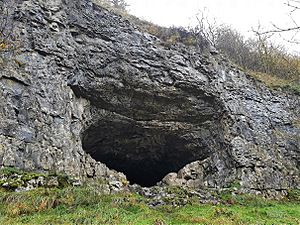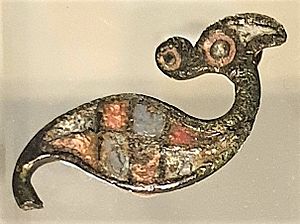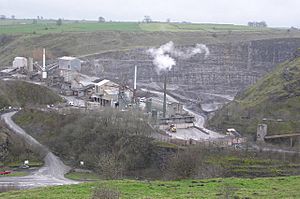Deep Dale facts for kids
Quick facts for kids Deep Dale |
|
|---|---|

Deep Dale near King Sterndale
|
|
| Length | 2 miles (3 km) |
| Width | 200 metres (656 ft) |
| Depth | 70 metres (230 ft) |
| Geography | |
| Location | Derbyshire, England |
| Rivers | A winterbourne stream |
Deep Dale is a beautiful, narrow valley with steep sides. You can find it near Buxton, in the Peak District of England. There's another valley also called Deep Dale, about 6.4 kilometers (4 miles) east, near Sheldon.
This valley cuts through a flat area of farmland. It's located just southwest of a small village called King Sterndale. The very start of the valley is known as Back Dale. There's also a smaller valley branching off called Horseshoe Dale. At the northern end of Deep Dale, you'll find Wye Dale. During summer, the valley can be dry. However, it has a special stream called a winterbourne. This stream flows from the Deepdale Side Resurgence spring and another spring near Thirst House Cave. The water from this stream eventually flows into the River Wye.
Contents
Thirst House Cave: A Mysterious Discovery
Thirst House Cave is a fascinating spot in Deep Dale. Its name comes from "Th'Hurst House," which was once called Hob Hurst House. People believed a goblin lived in this cave! (This is not the same as the ancient burial mound called Hob Hurst's House on Beeley Moor). The cave is 58 meters (about 190 feet) long.
Roman Treasures Found in the Cave
In the 1880s and 1890s, local men named Micah Salt and Robert Milletts explored the cave. They started digging after some boys found a bear's skull there. During their excavations, they made exciting discoveries. They found many objects from the Roman times. These included bronze jewelry, colorful brooches, pieces of pottery, coins, and a knife made of iron and bone. Many of these amazing items are now on display at the Buxton Museum.
Deep Dale's Amazing Nature Reserve
Deep Dale and Topley Pike are part of a special protected area. It's a nature reserve looked after by the Derbyshire Wildlife Trust. This area is also a designated Site of Special Scientific Interest (SSSI). This means it's very important for its plants and animals.
Plants and Trees in the Dale
The reserve is home to many different types of trees. You can find whitebeam, yew, ash, and hazel trees. On the lower rocky slopes, there's a plant called limestone fern. The steep upper slopes are covered with bilberry and cowberry. You'll also see beautiful wild flowers like bloody crane's bill, clustered bellflower, rock rose, and Nottingham catchfly. Because sheep don't graze here, native grasses like meadow oat and carnation sedge can grow freely.
Animals Living in the Cliffs
The tall limestone cliffs in Deep Dale are a great home for birds. Kestrels and jackdaws often make their nests there.
Exploring Deep Dale: Paths and Climbing
Deep Dale is a popular place for outdoor activities. Several walking paths go through or near the valley.
Popular Walking Routes
- The Buxton to Chelmorton part of the Midshires Way long-distance path crosses Deep Dale.
- The Priest's Way path goes right through the bottom of Deep Dale and Horseshoe Dale.
- The Peak District Boundary Walk route comes down Deep Dale, goes along Wye Dale, and then heads north at Chee Dale.
Rock Climbing Challenges
The steep cliffs of carboniferous limestone in Deep Dale are very popular with rock climbers. There are four main rock faces, called buttresses, along the valley. These buttresses offer many different climbing routes for people to enjoy.
Topley Pike Quarry: A Look at Limestone Mining
At the northwest end of Deep Dale, you'll find Topley Pike Quarry. This is a very large limestone quarry. It first opened in 1907. Today, a company called Tarmac Roadstone Holdings Ltd. operates it. A stone wall runs along the bottom of the valley. This wall marks the old boundary between different mining areas.
How to Visit Deep Dale
Getting into the deep valley can be a bit tricky. The easiest way for visitors to start their walk is from the Wye Dale car park. This car park is located across the A6 road at the north end of Deep Dale.
Other Entry Points
There are four other places where you can enter the dale and its nature reserve. These entry points are over stiles from nearby valleys like Chelmorton, King Sterndale, Horseshoe Dale, and Brierlow Dale. Be aware that these paths have steep slopes.
Footpath Closure for Nature
A footpath through the lower part of Deep Dale was closed in 2017. This closure is for a special reason: to help the area recover naturally. A large pile of waste material from the quarry, called a spoil tip, was removed. The path is expected to reopen in 2025. While it's closed, there's a different path you can use to the east.




